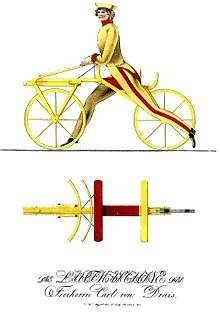Dandy horse
The dandy horse, a derogatory term for what was first called a Laufmaschine (in German), then a vélocipède or draisienne (in French and then English), and then a pedestrian curricle or hobby-horse,[1] is a human-powered vehicle that, being the first means of transport to make use of the two-wheeler principle, is regarded as the forerunner of the bicycle. A dandy horse is powered by the rider's feet on the ground instead of the pedals of later bicycles. It was invented by Karl Drais (who called it a Laufmaschine [German: [ˈlaʊfmaˌʃiːnə], "running machine"]) in 1817, and then patented by him in France in February 1818 using the term vélocipède. It is also known as a Draisine (German: [dʁaɪˈziːnə] (![]()


History
The dandy-horse was a two-wheeled vehicle, with both wheels in-line, propelled by the rider pushing along the ground with the feet as in regular walking or running. The front wheel and handlebar assembly was hinged to allow steering.
Drais was inspired, at least in part, by the need to develop a form of transit that did not rely on the horse. After the eruption of Mount Tambora and the Year Without a Summer (1816), which followed close on the devastation of the Napoleonic Wars, widespread crop failures and food shortages resulted in the deaths of tens of thousands of horses, which either starved to death or were killed to provide meat and hides.[2][3] "In wartime," he wrote, "when horses and their fodder often become scarce, a small fleet of such wagons at each corps could be important, especially for dispatches over short distances and for carrying the wounded.”[2]
Several manufacturers in France and England made their own dandy-horses during its brief popularity in the summer of 1819—most notably Denis Johnson of London, who used an elegantly curved wooden frame that allowed the use of larger wheels. Riders preferred to operate their vehicles on the smooth pavements instead of the rough roads, but their interactions with pedestrians caused many municipalities worldwide to enact laws prohibiting their use.[2] Later designs avoided the initial drawback of this device when it had to be made to measure, manufactured to conform with the height and the stride of its rider. An example is Nicéphore Niépce's 1818 model with an adjustable saddle for his 'velocipede' built by Lagrange.[4]
However, in the 1860s in France, the vélocipède bicycle was created by attaching rotary cranks and pedals to the front-wheel hub of a dandy-horse.
Modern adaptation
.jpg)
The dandy horse has been adapted as a starter bicycle for children, and is variously called a balance bike or run bike.
In popular culture
Buster Keaton rides a dandy-horse in his 1923 film Our Hospitality, which is set in the 1830s. Keaton's technical crew were unable to obtain a vintage dandy horse, so they built one to match existing drawings and prints. Keaton later donated the machine to the Smithsonian Institution, which had lacked an authentic example.
George Arliss, as the title character of the 1929 film Disraeli, rides a dandy-horse through a London park until he collides with a pedestrian. This occurs in the opening scene of the film, set in the 1830s, when Disraeli was still a writer and a famous dandy.
In the 1997 film Amistad, a citizen is briefly seen riding a dandy-horse through a forest trail when the escaped slaves first land on American soil.
A bi-annual magazine called "dandyhorse",[5] based in Toronto, Canada, promotes art, fashion and cycling culture.
Literature
- H.E.Lessing: How sophisticated was the draisine? The Boneshaker #159 (2002)
- T.Hadland and H.E.Lessing: Bicycle Design - An Illustrated History, MIT Press, Cambridge; MA 2014
- C.Reynaud: L'Ère de la Draisienne en France 1818-1870, Éditions Musée Vélo-Moto, Domazan 2015
See also
References
- Bicycle at Britannica.com
- Townsend, Chris (2016-10-25). "Year Without a Summer". The Paris Review. Retrieved 2019-05-07.
- Javorsky, Nicole. "How the 'Year Without a Summer' Inspired a Transportation Invention". CityLab. Retrieved 2019-05-07.
- Nicéphore Niépce Museum, Other Inventions - The velocipede Archived December 20, 2005, at the Wayback Machine
- "Home". dandyhorsemagazine.com. Retrieved 22 April 2018.
External links
| Wikimedia Commons has media related to Dandy horses. |
- New Scientist issue 2484, 29 January 2005, "Histories: Brimstone and bicycles"(subscription required)